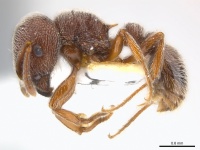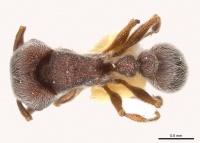Tetramorium rothschildi
| Tetramorium rothschildi | |
|---|---|

| |
| Scientific classification | |
| Kingdom: | Animalia |
| Phylum: | Arthropoda |
| Class: | Insecta |
| Order: | Hymenoptera |
| Family: | Formicidae |
| Subfamily: | Myrmicinae |
| Tribe: | Crematogastrini |
| Genus: | Tetramorium |
| Species group: | solidum |
| Species: | T. rothschildi |
| Binomial name | |
| Tetramorium rothschildi (Forel, 1907) | |
Tetramorium rothschildi has been found nesting in red laterite soils; sometimes nests have grass husks around the entrance.
Identification
Mbanyana et al. (2018) - Tetramorium rothschildi is the only species in the T. solidum group with branched hairs.
Keys including this Species
- Key to Afrotropical Tetramorium ericae osiris inezulae gabonensis species groups
- Key to Afrotropical Tetramorium solidum species group
- Key to Afrotropical Tetramorium species groups
Distribution
Latitudinal Distribution Pattern
Latitudinal Range: 1.11667° to -4.1°.
| North Temperate |
North Subtropical |
Tropical | South Subtropical |
South Temperate |
- Source: AntMaps
Distribution based on Regional Taxon Lists
Afrotropical Region: Ethiopia (type locality), Kenya.
Distribution based on AntMaps
Distribution based on AntWeb specimens
Check data from AntWeb
Countries Occupied
| Number of countries occupied by this species based on AntWiki Regional Taxon Lists. In general, fewer countries occupied indicates a narrower range, while more countries indicates a more widespread species. |

|
Estimated Abundance
| Relative abundance based on number of AntMaps records per species (this species within the purple bar). Fewer records (to the left) indicates a less abundant/encountered species while more records (to the right) indicates more abundant/encountered species. |

|
Habitat
Known from grassland and open woodland areas with laterite soil.
Biology
Castes
Nomenclature
The following information is derived from Barry Bolton's Online Catalogue of the Ants of the World.
- rothschildi. Triglyphothrix rothschildi Forel, 1907c: 134 (w.) ETHIOPIA. Menozzi & Consani, 1952: 67 (q.m.). Combination in Tetramorium: Bolton, 1985: 247. See also: Bolton, 1976: 334.
Unless otherwise noted the text for the remainder of this section is reported from the publication that includes the original description.
Mbanyana et al. (2018) - Tetramorium rothschildi was first placed in the genus Triglyphothrix because of its branched pilosity (Bolton 1976). After Bolton (1985) revised the status of Triglyphothrix, he placed this species in the T. solidum group because of the deep indentation on the anterior clypeal margin. Despite Bolton’s decision and our current treatment of this species as a member of the T. solidum group, we are not at all convinced that this species is a genuine member of the group. It is possible that T. rothschildi represents a convergent evolutionary lineage and the similarities in morphology are based on a similar granivore lifestyle. However, at present, it is not possible to address this question without a molecular phylogenetic framework.
Description
Worker
Mbanyana et al. (2018) - (N = 5) HL 1.033–1.131 (1.068); HW 1.072–1.259 (1.121); SL 0.698–0.797 (0.745); EL 0.197–0.226 (0.212); PH 0.541–0.600 (0.570); PW 0.659–0.757 (0.708); WL 0.934–1.141 (1.060); PSL 0.216–0.285 (0.252); PTH 0.325–0.413 (0.378); PTL 0.315–0.374 (0.342); PTW 0.354–0.433 (0.384); PPH 0.354–0.413 (0.385); PPL 0.285–0.334 (0.299); PPW 0.393–0.492 (0.444); OI 18–21 (19); CI 102–111 (105); SI 63–70 (67); DMI 64–72 (67); LMI 48–58 (54); PSLI 21–26 (24); PeNI 53–57 (54); LPeI 85–97 (91); DPeI 107–117 (112); PpNI 56–66 (63); LPpI 73–81 (78); DPpI 133–172 (149); PPI 105–122 (116).
Type Material
Mbanyana et al. (2018) – Holotype. Ethiopia: pinned worker, Harar, 1 Mar. 1905, Maurice de Rothschild leg. (Musee National d'Histoire Naturelle: CASENT0915429).
References
- Bolton, B. 1976. The ant tribe Tetramoriini (Hymenoptera: Formicidae). Constituent genera, review of smaller genera and revision of Triglyphothrix Forel. Bull. Br. Mus. (Nat. Hist.) Entomol. 34: 281-379 (page 334, see also)
- Bolton, B. 1985. The ant genus Triglyphothrix Forel a synonym of Tetramorium Mayr. (Hymenoptera: Formicidae). J. Nat. Hist. 19: 243-248 (page 247, Combination in Tetramorium)
- Forel, A. 1907f. Fourmis d'Ethiopie récoltées par M. le baron Maurice de Rothschild en 1905. Rev. Entomol. (Caen) 26: 129-144 (page 134, worker described)
- Mbanyana, N., Hita Garcia, F., Robertson, H.G., Le Roux, J.J. 2018. A taxonomic revision of seed harvester ants of the Tetramorium solidum group (Hymenoptera: Formicidae) in southern Africa. European Journal of Taxonomy 454: 1–59 (DOI 10.5852/ejt.2018.454).
- Menozzi, C.; Consani, M. 1952 [1951]. Missione biologica Sagan-Omo diretta dal Prof. E. Zavattari. Hymenoptera Formicidae. Riv. Biol. Colon. 11: 57-71 (page 67, queen, male described)
References based on Global Ant Biodiversity Informatics
- Bolton B. 1976. The ant tribe Tetramoriini (Hymenoptera: Formicidae). Constituent genera, review of smaller genera and revision of Triglyphothrix Forel. Bulletin of the British Museum (Natural History). Entomology 34:281-379.
- Diame L., B. Taylor, R. Blatrix, J. F. Vayssieres, J. Y. Rey, I. Grechi, and K. Diarra. 2017. A preliminary checklist of the ant (Hymenoptera, Formicidae) fauna of Senegal. Journal of Insect Biodiversity 5(15): 1-16.
- Garcia F.H., Wiesel E. and Fischer G. 2013.The Ants of Kenya (Hymenoptera: Formicidae)Faunal Overview, First Species Checklist, Bibliography, Accounts for All Genera, and Discussion on Taxonomy and Zoogeography. Journal of East African Natural History, 101(2): 127-222
- IZIKO South Africa Museum Collection
- Mbanyana N. 2013. Taxonomy, phylogeny and biogeography of seed-harvesting ants in the Tetramorium solidum-group (Hymenoptera: Formicidae). Masters of Science in the Department of Botany and Zoology at Stellenbosch University 115 pages.
- Mbanyana N., F. Hita Garcia, H. G. Robertson, and J. J. Le Roux. 2018. A taxonomic revision of seed harvester ants of the Tetramorium solidum group (Hymenoptera: Formicidae) in southern Africa. European Journal of Taxonomy 454: 1-59.
- Menozzi C., M. Consani. 1952. Missione biologica Sagan-Omo diretta dal Prof. E. Zavattari. Hymenoptera Formicidae. Rivista di Biologia Coloniale 11: 57-71.
- Wheeler W. M. 1922. Ants of the American Museum Congo expedition. A contribution to the myrmecology of Africa. VIII. A synonymic list of the ants of the Ethiopian region. Bulletin of the American Museum of Natural History 45: 711-1004

